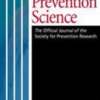Using a developmental, social–ecological approach to understand the etiology of health-risk behavior and inform primary prevention efforts, we assess the predictive effects of family and neighborhood social processes on youth physical fighting and weapon carrying. Specifically, we focus on relationships among youth and their parents, family communication, parental monitoring, as well as sense of community and neighborhood informal social control, support, concerns, and disorder. This study advances knowledge through its investigation of family and neighborhood structural factors and social processes together, employment of longitudinal models that estimate effects over adolescent development, and use of self-report and observational measures. Data from 1,093 youth/parent pairs were analyzed from the Youth Assets Study using a Generalized Estimating Equation approach; family and neighborhood assets and risks were analyzed as time varying and lagged. Similar family assets affected physical fighting and weapon carrying, whereas different neighborhood social processes influenced the two forms of youth violence. Study findings have implications for the primary prevention of youth violence, including the use of family-based approaches that build relationships and parental monitoring skills and community-level change approaches that promote informal social control and reduce neighborhood concerns about safety.
http://link.springer.com/article/10.1007%2Fs11121-013-0400-z




Comments (0)